Aihole is a small village in Bagalkot district of the Northern Karnataka. The first capital of powerful Chalukyan Empire looks like any other ordinary village in its modern appearance. Most of the houses are in dilapidated conditions. Miserable conditions of villagers are visible everywhere. The narrow alleys are filled with domestic animals, piles of dung, garbage dumps and occasional storage of dry woods. In the middle of all, ASI (Archaeological Survey of India) boards are placed at various places along the street to indicate the temples of historical importance. The ancient temples and local houses of Aihole have become such that it is difficult to decide when the boundary of a house ends and the courtyard of a temple begins. That’s Aihole, a living testimony of Chalukyan glory and an open-air museum of the ancient history.
The ruins of temples that stood for centuries have become an integral part of the lives of the villagers. In the courtyard of the temples, the buffaloes search for the fodder, local residents make gossip on the raised platforms, women make dung cakes on the outer boundary walls and children play in and out. Over the time, the Archaeological Department has undoubtedly tried safeguarding them from encroachment by building a boundary wall around several temple groups, but the situation is not much encouraging. The condition is such that the temples were named not after the deity, but in the name of those people who in the past lived there.
Few years ago, the state government has decided to relocate the residents of Aihole village to protect the monuments from further deterioration. The process is likely to complete soon. It will help the government agencies to preserve the old glory of Aihole in an efficient way and to develop the proper tourism infrastructure in the area.
Contents
Location of Aihole
Aihole is situated on the bank of Malaprabha River in Bagalkot district of Karnataka. It is about 33 km from Badami, the nearest town. Pattadakal, a UNESCO World Heritage Site, is 11 km before Aihole on Badami-Pattadakal-Aihole Road.
Entry Tickets: Most of the temples are scattered at the various locations in Aihole Village and don’t require any entry ticket. However, the prominent temples at Aihole like Durga Temple, Lad Khan Temple, Badiger Temple etc are enclosed within a boundary wall. An entry ticket is required to visit the temples. Entry fee is Rs 20 for Indian citizens. Rs 200 for foreigners. Camera charge is Rs 25. These prices also include the entry fee to the museum in the same complex. Entry is free for the children below 15 years of age.
Visiting Hours: The main temples complex is open from 1000 AM to 0500 PM. Except the main temple complex, you can visit other temples at your own wish. Entrance to many temples has been protected by putting a gate on the boundary wall, but either you can easily open the gate and go inside comfortably or you may find a cracked portion in the boundary wall to enter in the temple complex. Most of the temples are deserted and no one is there to monitor the visitors.
What is Aihole Famous For?
It is a place of great heritage and religious interest containing several temples within a closed enclosure of an area of over 400 meters in length. The ancient temples are not only inside the particular enclosure. In fact, entire Aihole village is marked by the temples and many more interesting structures scattered around in the open fields. In all there are about 125 temples at Aihole, big and small, most of them in old and ruined condition. In the words of Percy Brown it is ‘One of the cradles of Temple Architecture’.
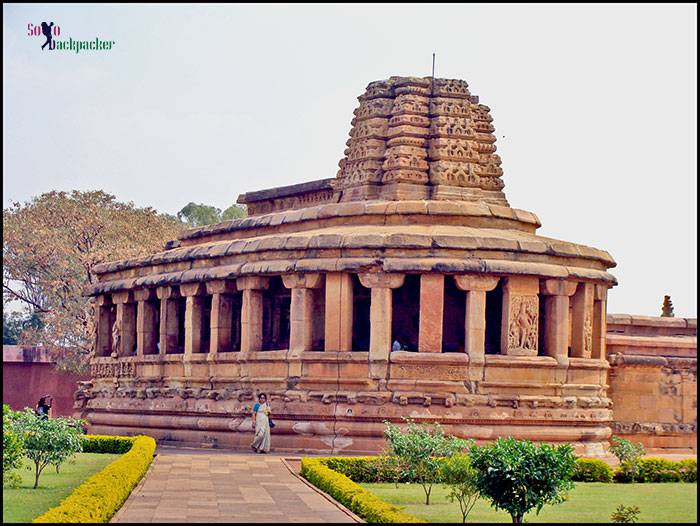
At Aihole, a new medium was being used for temple construction. Blocks of stone were used for vertical construction. This was a new kind of architecture. Before this, the rock-cut monuments were dominant in the Indian temple architecture. For a period of two centuries (the sixth and the seventh) and then again in the twelfth the thirteenth centuries, art activities thrived at Aihole with great enthusiasm.
Mythological Origin of Aihole
Aihole was known as Aryapura and Ayyavole in the ancient inscriptions. It was probably the earliest capital of the Chalukyas. Along with Badami (ancient Vatapi) and Pattadakal (ancient Patta-Kisuvolal), it was their earliest and most important city. The capital was shifted to Vatapi due to the strategic reasons.
Badami was the great capital of Chalukyan Empire. Read about Badami: A Beautiful Town Of The Cave Temples
In the mythology, it is believed that after destroying the race of the Kshatriyas and having avenged the death of his father, Sage Parashuram came to the Malaprabha River to wash his blood stained hands and the axe. At the sight of the river, he cried ‘Ai ai ! Holi!’ (Ah! the river!). Hence, the name ‘Aihole’. It has a natural axe-shaped rock on the Malaprabha river bank north of the village, and a rock in the river shows a footprint of Sage Parashuram.
Another version of story says that the river water turned red due to the blood on the axe. A local lady saw the red water and shouted ‘Ayyo, Hole!’ (Oh No, Blood!) and hence the name ‘Aihole’.
According to another legend, Sage Agasthya is believed to have killed Vatapi’s brother, the giant Ilvala here and thus the name ‘Ilavalapura’. Another version said the name ‘Aihole’ came from the words ‘Ayya hole’, or city of scholars (in Sanskrit, Arya Pura).
Beautiful Temples at Aihole
The temple complex at Aihole is an interesting piece of Hindu Temple Architecture. It was the place where some of the earliest structural temples of the Hindus were built from the sixth century onwards.
Earlier Hindu Temple architectures were based on the rock-cut temples, but at Aihole, the blocks of stone were used for vertical construction. That was a new kind of architecture. From the simple beginning in the Konti-Gudi group and the Lad Khan to the more evolved forms at Durga Temple, Aihole represents a prominent form of Indian temple architecture.
There are at least 100 temples scattered in and around the village of Aihole. Most of them are Vaishnavite temples later converted into Saivite ones. Among them the following are the important temples:
Durga Temple
Durga Temple stands majestically in the group of temples at Aihole Complex. It is the most imposing structure that strikes the eye when you see the temples at Aihole. That’s why it is considered as one of the finest temples at Aihole. Although the temple is named as Durga Temple, but it is not because of its dedication to Goddess Durga, but because of the word दुर्ग (Durga) meaning a fortress. The original dedication of the temple may have been to the sun god Surya or perhaps either Vishnu or Shiva as the representations of Vishnu are as numerous as those of Shiva.
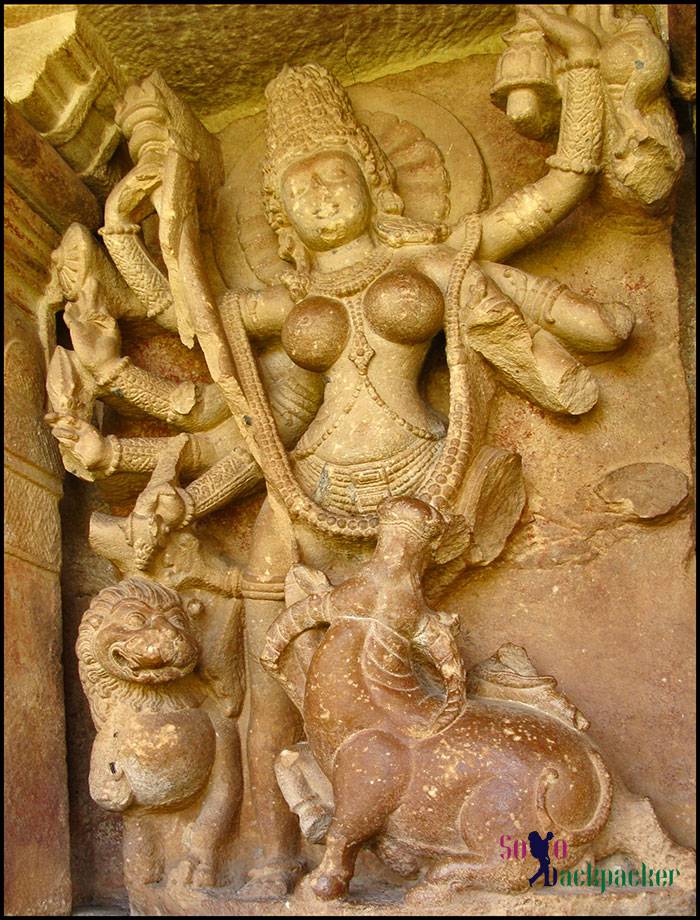
It is an example of Gajaprishtha (elephant-back, temple architecture resembling an elephant back) temples with the walled enclosure and an apsidal plan (rectangular at the front and semi-circular at the back). The temple stands facing East.
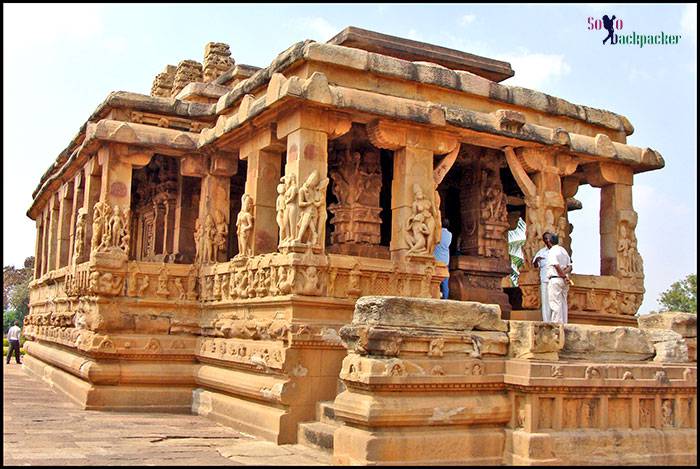
A pillared corridor circumnavigates the entire temple. The ceiling has a beautiful relief of Matsya-chakra. There are intricate latticed windows and beautiful reliefs all around. The temple is exquisitely adorned with sculptures like Mithuna, Vishnu on Garuda, Harihara, Mahishasurmardini etc.
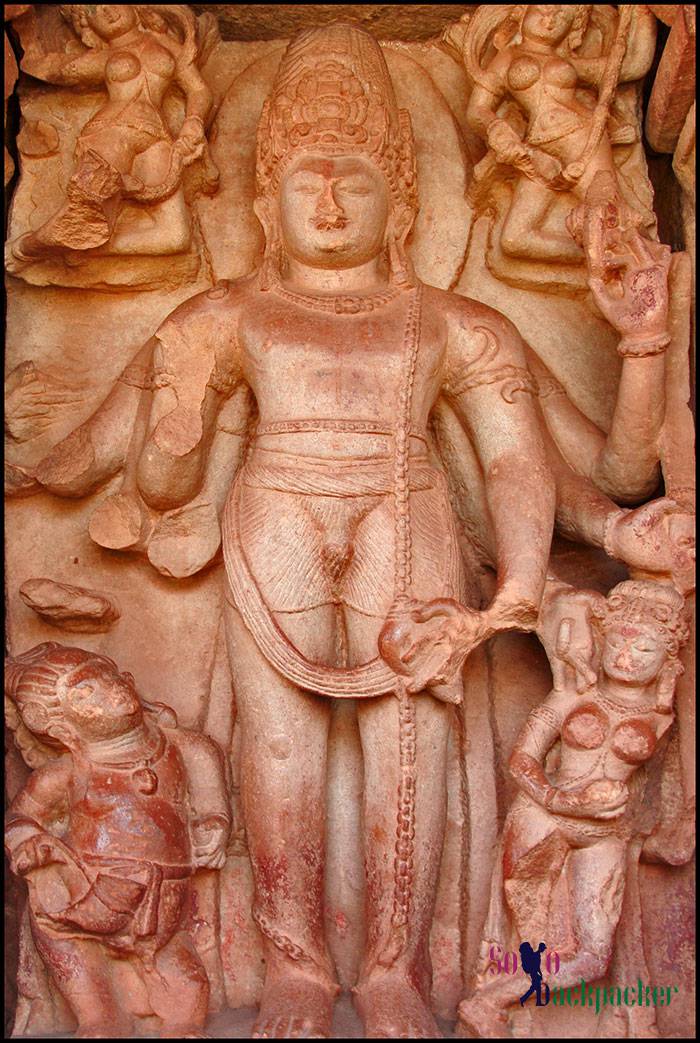
An interesting feature of this temple is that no cementing mortar was used during the construction. Stones were fixed into each other by making grooves and offsets. The ceiling was supported by building load-bearing walls and pillars.
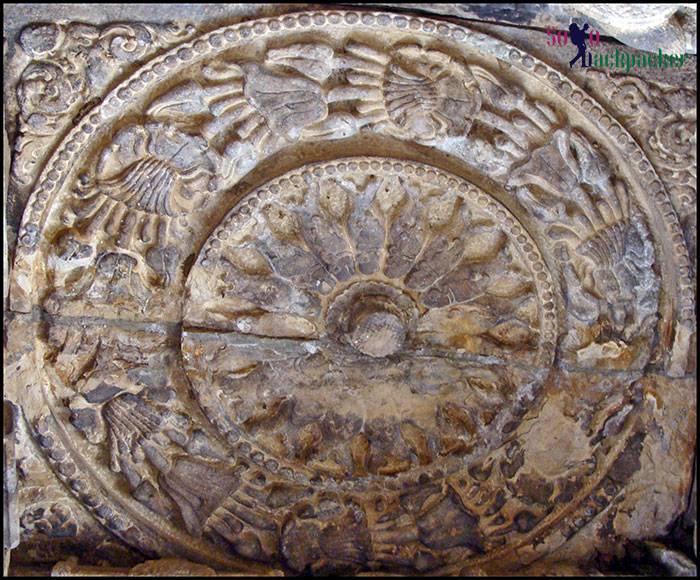
Lad Khan Temple
One of the earliest temples at Aihole, the Lad Khan is a beautiful temple consisting of a large pillared porch, a large squared pillared hall with large lattice windows and small rectangular sanctum at the rear, projecting into the hall. The central hall is topped by a small rooftop shrine surrounded on four sides by slopping roof. The joints of the roof slabs are protected by log-like stone strips that looks like timber logs.
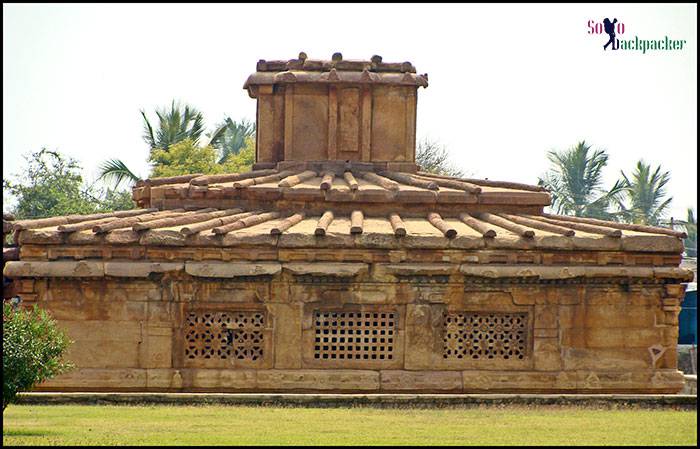
The pillars of the temple are heavy and massive in proportion as they have to support a heavy stone roof. A big stone Nandi is placed in the central hall. The windows at the outer wall have beautiful floral design. The inner sanctum has a Shiva Linga, that might have placed in the later stage. The temple is now dedicated to Lord Shiva, but originally may have enshrined some other deity.
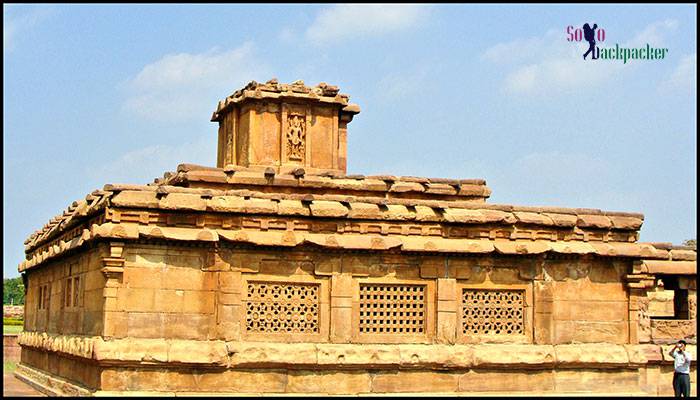
In the later years, the temple is identified after a Muslim Commander ‘Lad Khan’ of Adil Shahi Rulers who briefly camped here during an armed campaign.
Badiger Gudi Temple
This is a Badami Chalukyan temple erected in the 9th century. Also famous as the carpenter’s temple, because of the carpenter family that used to live here before the site was taken over by the Archaeological department. The temple is in ruined state and nothing interesting is noticeable except the pyramidal tower that rises over the temple sanctuary.
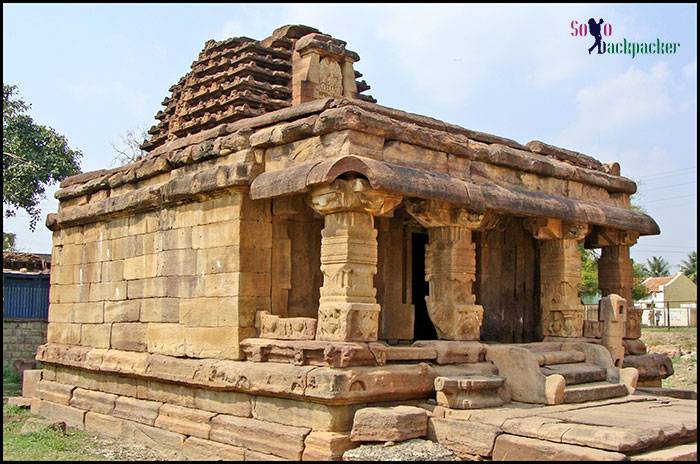
The temple is plain in design except the porch, the columns of which have circular designs incised onto their shafts. The temple was originally a Surya temple, as indicated by the Surya image on the projection of curvilinear tower on the garbhagriha (sanctum).
Ambigera Gudi Complex
This group of temple is located outside the main temple complex, to the west of the Durga Temple, on the other side of the road. This is a group of three temples. As the Ambiger community (boatsmen) stayed near it, the complex has secured this name.
The larger temple has Nagara Shikhara and it has a sanctum and a pillared hall. There are two entrances to the right and left of the hall. The inner ceiling of the hall has a lotus engraved. The door-frame of the sanctum is highly embellished. This tenth century temple stands on an elevated platform.
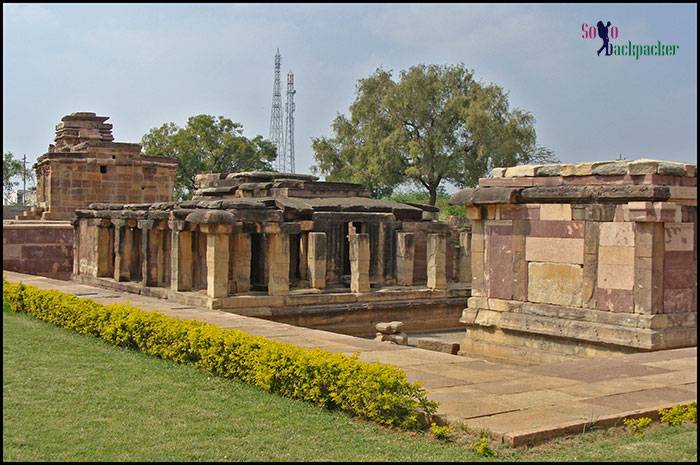
The second temple is an ordinary structure, but there is a broken image of Surya or Vishnu and two female figures. The third west-facing temple is an ordinary one.
Ravana Phadi Cave Temple
The cave-temple of Ravana-Phadi is situated on a small hillock in the North-East direction, few meters away from the Durga Temple. A huge monolithic fluted pillar with a square base is seen in front of the cave. This is a Shiva cave with a loose Nandi on a high platform outside and a rock-cut linga inside the sanctum. The temple has a veranda-type hall, a side chamber, an antechamber of rectangular shape and a rectangular sanctum.
Inside the veranda-like hall, on the left to the entrance, is the sculpture of Ardhanarishvara, standing on a lion-pedestal. The right half is male and left half is female. A gana sculpture is there near the right of Ardhanarishvara. The ceiling of the main hall is beautifully carved. A standing figure of Shiva resting on the right foot and holding a huge long trishula in the right hand can be seen on the left back wall of the hall. Other important sculptures include the images of Harihara, Dancing Shiva with Parvati, Vaishnavi, Ganesha, Mahishashurmardini, Varaha, Gangadhara Shiva-murti etc.
Raachi Gudi
This is an 11th century Kalyana Chalukyan Temple dedicated to Lord Shiva. The erection of this temple represents the transition from Rashtrakuta to Kalyana Chalukya. It has a portico, a central hall opening into the main sanctum, and two subsidiary sanctum on the east and the west. The temple is on a high pedestal.
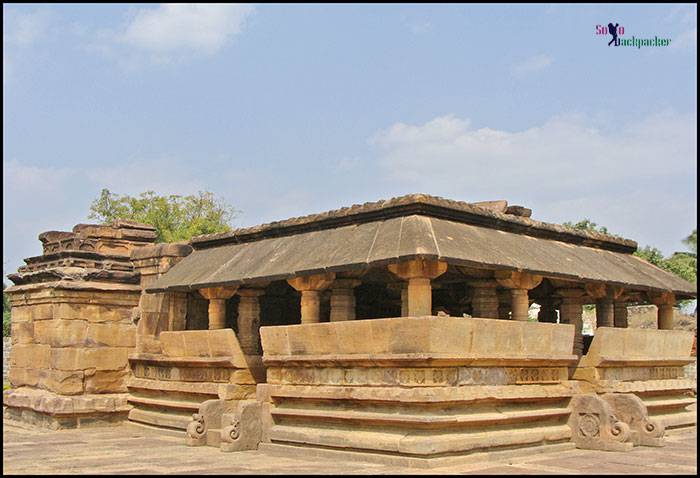
The temple has three sanctums (garbhagrihas). The sanctums have a common antechamber with entrances in three directions. Only two shikharas (tower) on the sanctums remain. The north sanctum carries on its walls figured of Ganesha, Nataraja, Bhairava, Vishnu etc.
The portico is supported by four central pillars placed on a slightly raised platform. Nandi is placed on this platform seated facing the sanctum. There is a sloping roof on the three sides.
Veniyavara Gudi
This is a group of ten temples. The main temple of this group stands with its entrance facing the south. The positioning of the main hall and the sanctum is in the east-west direction. The entrance door to the main hall has a sculpture of Gajalakshmi on the lintel. Sculptures are also found on the doors.
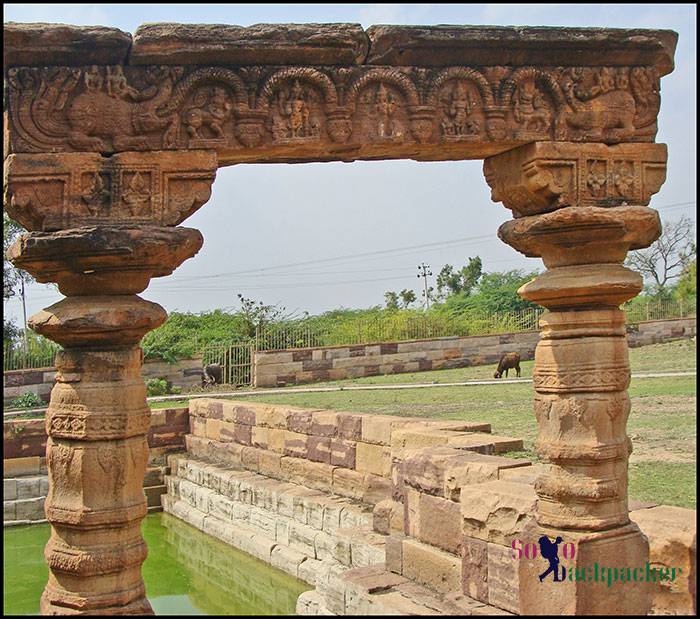
Besides the northernmost temple exists a stepped well entered through a torana that bears the figures of lions, Shiva and Brahma on east face and Gajalakshmi on west.
Jain Temple on Meguti Hill
The Jain Temple, located on the Meguti Hill, is one of the finest examples of early-Chalukyan architecture. This is the only dated temple at Aihole and considered as a landmark in the Jain Temple architecture in Karnataka. The presence of an upper storey in this temple is noteworthy. Though the Lad Khan Temple came to be added with an upper shrine, the Hindu structures are rarely found with an upper shrine, but the Jains continued to erect two storied structures. The roof of the upper shrine at Meguti Jain Temple has been lost and the four walls are the only remnants.
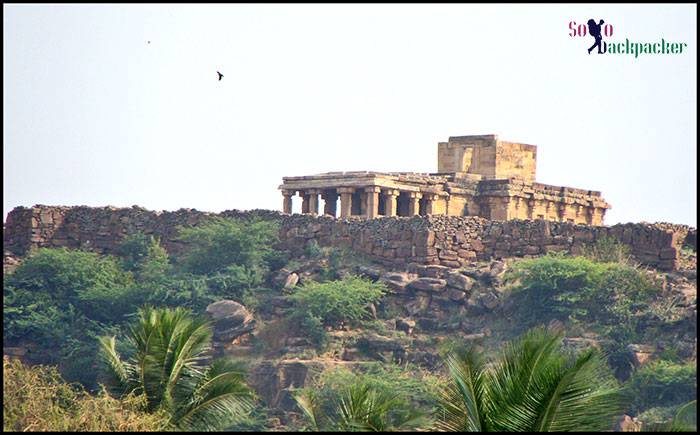
The Meguti Temple is a fully developed temple consisting a sanctum (garbhagriha), a circumambulating path, entrance porch and a pillared hall or porch. No other early-Chalukya temple at Aihole has so many components except the Durga Temple.
Other Temples
Chakra Gudi is known for its 20 sculptures of amorous couples engraved on the door-frame of the sanctum which has Garuda holding two snakes on the lintel. The temple has a prominent circular stone disk with ridges on the rim (amalaka) at the top (kalasha/stupi) which may have brought the name Chakragudi to the temple.
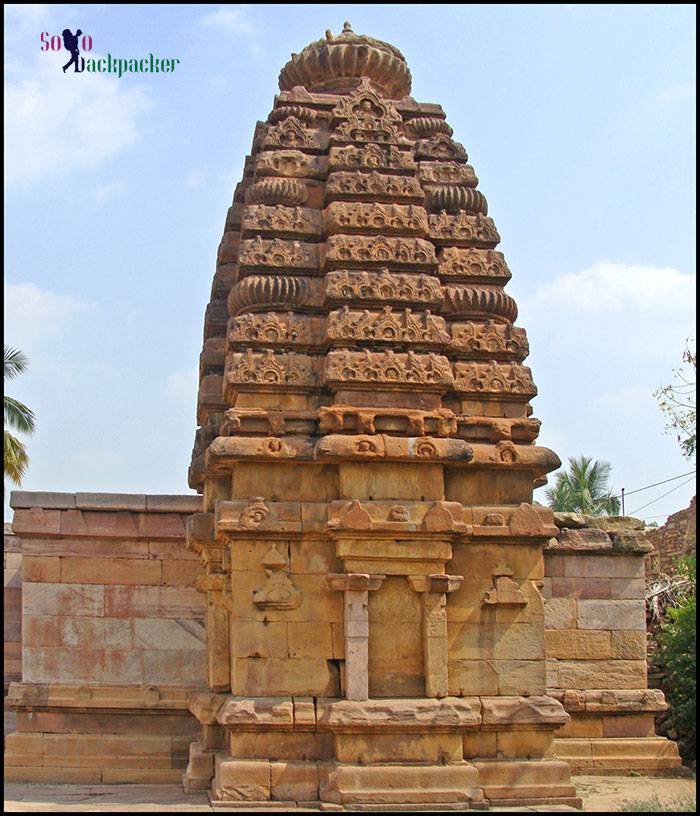
Gaudara Gudi is considered as the Bhagavati temple worshiped by the famous trade guild (Five Hundred Lords of Ayyavolu, a merchant guild that provided links between trading communities in South India) of Aihole. It has fine Chalukyan sculptures. This is perhaps the oldest temple having a circumambulatory passage in the design. A large stepped well exists beside the temple.
Read also about the impressive ruins of Hampi, the center of Vijayanagar Empire and another UNESCO World Heritage. Hampi: A Poetry in the stones
The Galagnath group of temples are situated at the bank of the river Malaprabha, slightly away from the village of Aihole in the southern direction. About thirty temples were erected here, many of which are in ruined condition now. The main temple, dedicated to Galagnath, is curvilinear, has an entrance porch, a central hall and a detached sanctum. The top of the shikhara is missing. A huge sculptured slab of Lord Vishnu on Garuda can be seen in front of the shikhara.
Other prominent temples of Aihole include Huchimalli Temple, Trymbakeshvara Group, Chikki Gudi, Hucchappayya Temple, Kunti Gudi, Mallikarjuna Temple Complex, Ramalinga groups etc. Apart from the temples, there is an archaeological museum at Aihole. The museum is located inside the Aihole Temple Complex, adjacent to the Durga Temple.
Best Time to Visit Aihole
Winter season from October to January, also February and March is the best time to visit Aihole. The summer is really hot. You can expect lush green surroundings and a gorgeous countryside during the monsoon, but area is also prone to the river floods.
How to Reach Aihole?
It lies to the north-east of Pattadakal, along the Malaprabha River, while Badami is to the west of both. The state highway running from Badami to Aihole via Pattadakal doesn’t offer good and frequent transport options. After visiting the temple complex at Pattadakal, I had to wait for 45 minutes to get a shared auto to Aihole. Frequency of the public buses is very less. While returning back from Aihole, I had to wait for one hour to travel by a bus (the last bus 0430 PM) to Badami. It is advisable to hire a taxi or an auto-rickshaw from Badami to visit Pattadakal and Aihole comfortably in a single day. If you can devote two days or more in the area, then public transport is also a good choice.
Where to Stay at Aihole?
A guest house Mayura Yatri Niwas (Phone: 08351-284666, 9448559892, 9742993991) is there at Aihole. This is the only option for night stay at Aihole. The guest house belongs to the tourism department and located at the walking distance from most of the temples. The services are very basic.
Most of the visitors stay at Badami and make a day-long trip to Aihole. That is the most convenient option because of the availability of good hotels in Badami.
Pattadakal Temples are UNESCO World Heritage. It was a significant town of Chalukyan Empire. Read More: Pattadakal Temple Complex
Aihole today is a small hamlet, where local life and ancient temples co-exist in a compact area. But it retains a unique place in the history of temple architecture in India. It was an experimental ground for the early Chalukyan kings to construct structural temples.


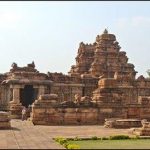
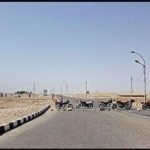
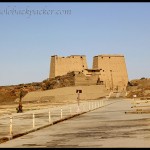
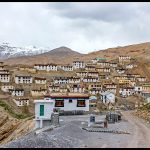
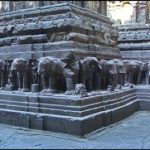

Images are great. i have visited but my notes were not as good as yours. Thank you for the refresher course. Love India what a wonderful place.
Thank you Maria. Your photographs are awesome.
i got all the information which i needed the most…….very nice!!
great work buddy. m planning the same trip as you did. badami, Pattadakal, Aihole & hampi.
Can you provide me the details such as where you stay ? veg. restaurants .
I will start my journey from mumbai & planning it in next month after 10 dec.
Thanks Sunil..Unfortunately, I am unable to give you an expert advice on the hotels and restaurants. I made a hurried weekend trip from Hyderabad. I started my trip on Friday Night and reached Badami on Saturday Morning. The same day I visited Badami, Pattadakal and Aihole. Then, I went to my friend’s place in Bellary for night stay and on Sunday, visited Hampi in a single day. In the night, I was on a bus to Hyderabad. You can see that I didn’t stay at any hotel in that area. 🙂 However, there are several decent hotels available in Badami. Don’t expect to stay at Pattadakal or Aihole. Later, there are plenty of places to stay in Hampi. If you are planning to spend more days in Hampi, then better to cross the river behind Hampi main market and find a hotel in that area. That area is a far better place to enjoy your night in Hampi, as suggested by some friends. Have a great trip.
the place is really rich in history and is beautiful. your shots was able to capture that. 😉
Thanks Ardee..Will be happy to meet you somewhere on the road.